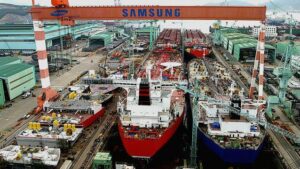Workers across South Korea’s shipbuilding industry are intensifying their labor actions protesting the shortage of skilled workers and the industry’s efforts to bring in less expensive foreign labor to meet the current shortages in key skills. The umbrella union that represents workers at eight of the major shipbuilders announced today that it would join the strike against Hyundai Heavy Industries.

Protests began in late April in response to the government’s announcement that it would relax visa requirements at the request of the shipbuilders. They committed to increasing the limit by five times its historic level to a total of 4,400 workers from lower cost Southeast Asian countries, including Vietnam, Thailand, and the Philippines. The new visas are specifically for skilled workers for the shipbuilding industry including welders, painters, and others with essential skills.
The move came after the shipbuilders pressed the government saying that they did not have enough skilled workers to keep pace with their orderbooks and the flow of new contracts. Each of the major shipyards is reporting that their orderbooks are full into 2024 with as many as 37 additional ships ordered in just the first three months of 2022. The 2022 orders were equivalent to half of 2021’s already elevated pace continuing the surge in business for the shipbuilders.
The unionized workers of Hyundai’s three shipyards, as well as Samsung Heavy Industries, Daewoo Shipbuilding & Marine Engineering, HSG Sungdong Shipbuilding, K Shipbuilding, and HJ Shipbuilding & Construction, are all supporting the labor actions. They are blaming the shipbuilders for creating the problem and now undermining the long-term health of the industry and their jobs.
The unions are calling for higher wages, improved labor conditions, and the rehiring of workers let go in recent years. The unions contend that employment fell from over 200,000 mid-decade to around 90,000 in 2021. Automation has offset some of the declines but many tasks they highlight required skilled workers. The unions argue the shipyards laid off too many workers and are doing little to attract young people to join the workforce.
In response to the move by the shipyards to bring in more foreign workers, the unions cited what they believe will be an increased danger and potential for accidents due to language and experience barriers. Long-term they are also saying that the South Korean yards are following a similar model to the Japanese shipbuilders which they contend led to the collapse of the Japanese industry.
The South Korean industry argues that it needs to increase the labor force if it is going to keep pace with the orders and meet delivery schedules. They contend that Japan’s industry collapsed due to high costs and a lack of workers, as well as the competitive pressures from South Korea, the same issues which are now confronting the yards in South Korea. By some estimates, the South Korean shipbuilding industry needs to add as many as 25,000 workers to meet the current workloads.
Read Also: Shipping Position Market Square As At Monday 9, May 2022
Faced with stiff competition from Chinese shipbuilders, the South Korean industry is also struggling to lower costs to meet the competition and address rising material costs. While the largest Korean shipbuilders all exceeded targets for 2021, they also all reported financial losses.
In addition to raising the visa quota, the government is also promising to support the industry by providing training for foreign workers to address issues such as a potential language barrier. The government’s longer-term strategy has been to shift the focus to higher-value new technologies such as autonomous shipping and alternative fuels to raise the value of the shipbuilding industry.
Kindly like us on Facebook















